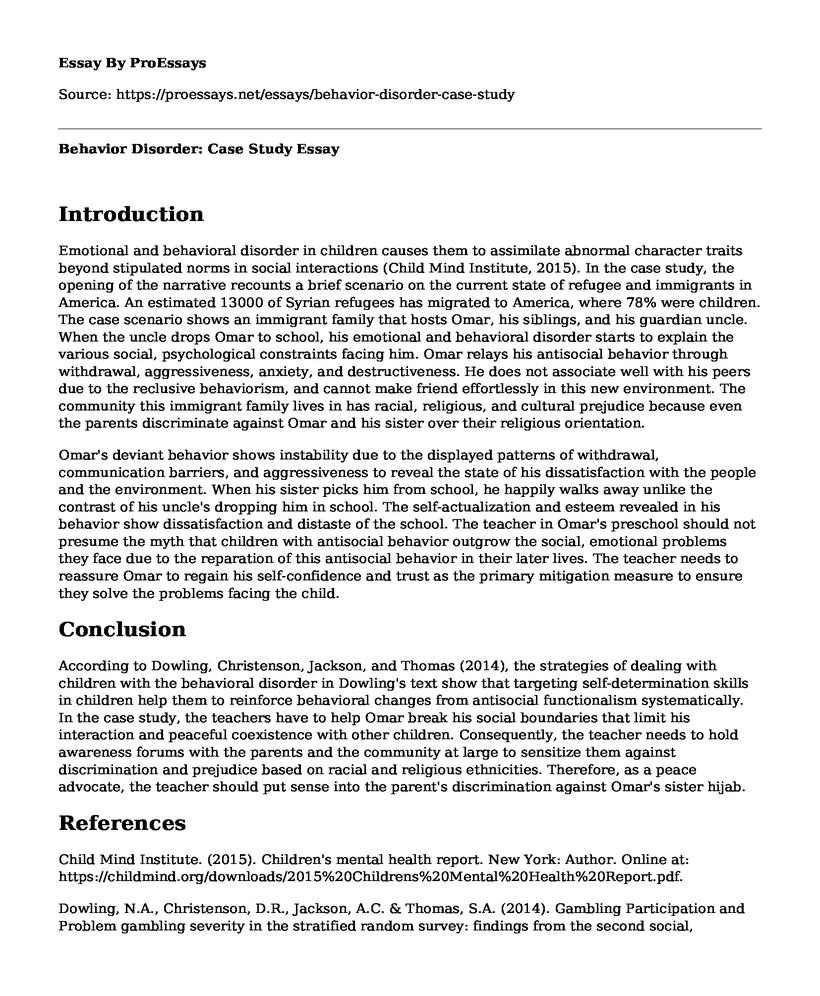Introduction
Emotional and behavioral disorder in children causes them to assimilate abnormal character traits beyond stipulated norms in social interactions (Child Mind Institute, 2015). In the case study, the opening of the narrative recounts a brief scenario on the current state of refugee and immigrants in America. An estimated 13000 of Syrian refugees has migrated to America, where 78% were children. The case scenario shows an immigrant family that hosts Omar, his siblings, and his guardian uncle. When the uncle drops Omar to school, his emotional and behavioral disorder starts to explain the various social, psychological constraints facing him. Omar relays his antisocial behavior through withdrawal, aggressiveness, anxiety, and destructiveness. He does not associate well with his peers due to the reclusive behaviorism, and cannot make friend effortlessly in this new environment. The community this immigrant family lives in has racial, religious, and cultural prejudice because even the parents discriminate against Omar and his sister over their religious orientation.
Omar's deviant behavior shows instability due to the displayed patterns of withdrawal, communication barriers, and aggressiveness to reveal the state of his dissatisfaction with the people and the environment. When his sister picks him from school, he happily walks away unlike the contrast of his uncle's dropping him in school. The self-actualization and esteem revealed in his behavior show dissatisfaction and distaste of the school. The teacher in Omar's preschool should not presume the myth that children with antisocial behavior outgrow the social, emotional problems they face due to the reparation of this antisocial behavior in their later lives. The teacher needs to reassure Omar to regain his self-confidence and trust as the primary mitigation measure to ensure they solve the problems facing the child.
Conclusion
According to Dowling, Christenson, Jackson, and Thomas (2014), the strategies of dealing with children with the behavioral disorder in Dowling's text show that targeting self-determination skills in children help them to reinforce behavioral changes from antisocial functionalism systematically. In the case study, the teachers have to help Omar break his social boundaries that limit his interaction and peaceful coexistence with other children. Consequently, the teacher needs to hold awareness forums with the parents and the community at large to sensitize them against discrimination and prejudice based on racial and religious ethnicities. Therefore, as a peace advocate, the teacher should put sense into the parent's discrimination against Omar's sister hijab.
References
Child Mind Institute. (2015). Children's mental health report. New York: Author. Online at: https://childmind.org/downloads/2015%20Childrens%20Mental%20Health%20Report.pdf.
Dowling, N.A., Christenson, D.R., Jackson, A.C. & Thomas, S.A. (2014). Gambling Participation and Problem gambling severity in the stratified random survey: findings from the second social, economic impact study on gambling in Tasmania. Journal of gambling Studies, 1 - 19.
Cite this page
Behavior Disorder: Case Study. (2022, Apr 02). Retrieved from https://proessays.net/essays/behavior-disorder-case-study
If you are the original author of this essay and no longer wish to have it published on the ProEssays website, please click below to request its removal:
- 13 Reasons Why Critical Essay
- Soft Power Influence Essay
- Critical Analysis: Specific Mental Health Risks for Refugees
- Social Work in Reducing Recidivism Paper Example
- Pathways Between Bullying Victimization, Depression, Academic Achievement, and Problematic Drinking in Adolescence
- Hansell's Theory for Unmet Human Needs: Attachments for Success - Essay Sample
- Essay Sample on Assessing Patient Cases: Depression, Dementia, Adoption, and Substance Abuse







